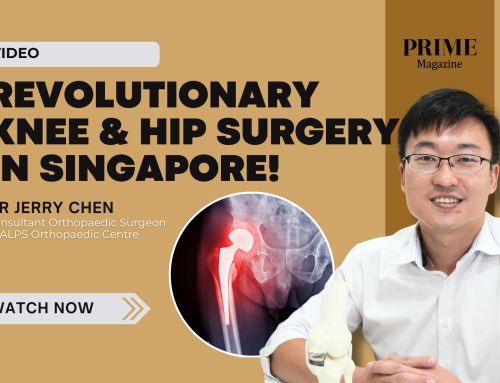Did you know that you can recover faster when undergoing total hip or knee replacement surgery through the specialised Enhanced Recovery After Surgery (ERAS) approach? With ERAS Total Hip and Knee Surgery, patients experience accelerated recovery, minimal postoperative pain and a shorter hospital stay.
ENHANCED RECOVERY AFTER SURGERY (ERAS)
ERAS is a patient-centered approach that involves a series of preoperative, intraoperative, and postoperative procedures aimed at reducing the psychological stress induced during surgery. The guidelines of ERAS aim to accelerate the recovery process while maintaining or improving the quality of patient care, ensuring that patients can quickly return to the daily activities they love.
This is achieved through meticulous attention to detail in surgical procedures, pain management, patient education, nutrition, and physical rehabilitation, making the entire surgical experience as seamless and efficient as possible.
So, how does ERAS differ from traditional surgical approaches? Let’s examine the three different stages: preoperative preparation, intraoperative techniques, and postoperative care.

PREOPERATIVE PREPARATION
The success of ERAS starts with comprehensive preoperative preparation. This phase involves educating the patient about the surgery, reducing anxiety, and setting realistic expectations. Assessments include detailed health evaluations to optimize the patient’s physical condition. For example, patients may be advised to improve their nutritional status, cease smoking, and manage chronic diseases such as diabetes or hypertension under medical supervision. These steps are crucial in minimizing surgical risks and enhancing postoperative recovery.
INTRAOPERATIVE TECHNIQUES
In an ERAS approach, surgeons employ minimally invasive techniques that reduce the body’s physiological stress, with minimal tissue damage and reduced pain. For hip replacements, the Direct Anterior Approach (DAA) allows surgeons to work between muscles rather than cutting through them, which helps to preserve muscle tissue and reduce pain. In knee replacements, techniques like kinematic alignment are employed to replicate the knee’s natural movement, enhancing the longevity of the implant.
POSTOPERATIVE CARE
The ERAS journey does not end with surgery; postoperative care is just as crucial. Immediate postoperative protocols include early mobilization, often within hours of surgery, to promote circulation and muscle function. Pain management is handled through multimodal pain relief strategies, avoiding heavy reliance on opioids. Nutritional support is tailored to aid healing and strength recovery. Moreover, follow up appointments are scheduled to monitor recovery, manage potential complications, and ensure patients remain engaged in their rehabilitative activities.
FASTER RECOVERY
After an ERAS Total Hip and Knee Replacement Surgery, your orthopaedic surgeon will recommend physiotherapy and wound care options to regain strength, flexibility, and stability in the operated knee, aiding in a swift return to normal activity. The surgeon may also suggest using a walking aid during the recovery process. Attending a structured rehabilitation program supervised by healthcare professionals is recommended. As the ERAS approach minimizes postoperative pain, patients can expect expedited recovery. A combination of good surgical technique, enhanced physiotherapy, and optimal nursing care accomplishes this. However, each patient’s recovery process will vary based on factors such as age, physical health, and the extent of joint damage.
An orthopaedic surgeon can assess your condition and provide a personalized recovery plan to address problems with your hip and knee. To book an appointment with Consultant Orthopaedic Surgeon, Dr. Jerry Chen, kindly contact Alps Orthopaedic Centre, a hip and knee surgical clinic conveniently located at Mt. Elizabeth Orchard Hospital, Singapore.
BENEFITS
Patients who undergo ERAS Total Hip and Knee Replacement would benefit from:
- Minimal Postoperative Pain: This specialized surgical procedure does not require the removal or detachment of any muscle tissues. It significantly reduces the risk of muscle atrophy and strength loss, common concerns for patients undergoing surgery. As a result, ERAS helps patients maintain a healthy baseline of muscle function post-surgery.
- Faster Recovery: The ERAS approach allows most patients to eventually return to normal activities, such as walking, running, and playing sports independently. Before gradually returning to sports, patients should undergo a thorough evaluation to ensure their operated knee joint can withstand the demands of rigorous physical activities. This assessment from your orthopaedic surgeon is necessary to prevent complications and ensure safe participation.
- Improved Surgical Outcomes: The Direct Anterior Approach (DAA) associated with ERAS hip replacement also utilizes an intraoperative imaging machine during the surgical process, allowing surgeons to evaluate a patient’s leg length and place the prosthesis with precision.
RISKS
As with any surgery involving anaesthesia, there is a slight risk of stroke, heart attack, pneumonia, and blood clot formation. While hip and knee replacement surgeries generally have low risks, there are potential rare risks associated with the procedure. These risks include the possibility of:
- Infection, which may occur in about 1% of patients. It can typically be managed easily with antibiotics. However, in rare cases, infection may require removal of the replacement joint and, in severe instances, can be life-threatening if it spreads throughout the body
- A fracture when handled by inexperienced hands.
- Wear and tear (85% of the implants last more than 20 years).
- Injury to surrounding neurovascular structures (very rare).
- Allergic reaction to the prosthetic component.
Recognizing the potential risks associated with this procedure underscores the importance of an ERAS approach and the necessity for specialized guidance from an orthopaedic surgeon throughout the preparation, procedure, and recovery. In general, most complications can be effectively managed. Even if complications arise post-surgery, success can usually still be achieved if pain relief and good function are attained in the long term.
WHEN TO SEE AN ORTHOPAEDIC SURGEON
Patients with hip arthritis and osteonecrosis are common candidates for hip replacement surgery. If you experience chronic pain in your hips and find that physical activities, such as prolonged walking, working out, bending down to pick something up, or climbing stairs, are painful, you may want to consult an orthopaedic surgeon.
An orthopaedic surgeon can assess your condition and provide a personalized recovery plan to address problems with your hip and knee. To book an appointment with Consultant Orthopaedic Surgeon, Dr. Jerry Chen, kindly contact Alps Orthopaedic Centre, a hip and knee surgical clinic conveniently located at Mt. Elizabeth Orchard Hospital, Singapore. PRIME












Leave A Comment